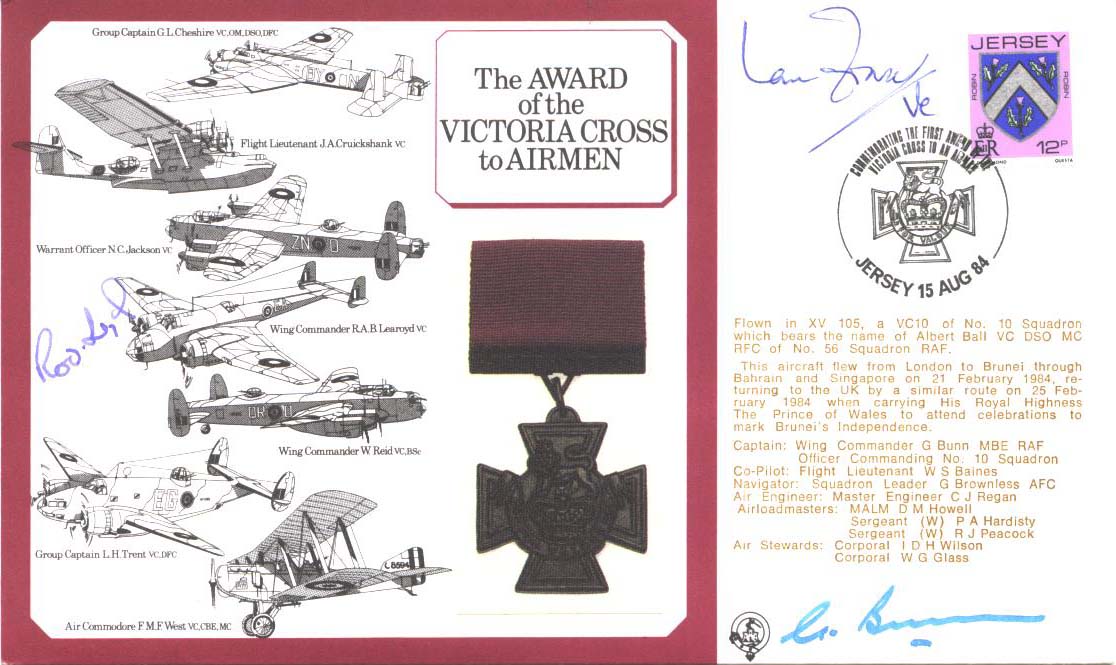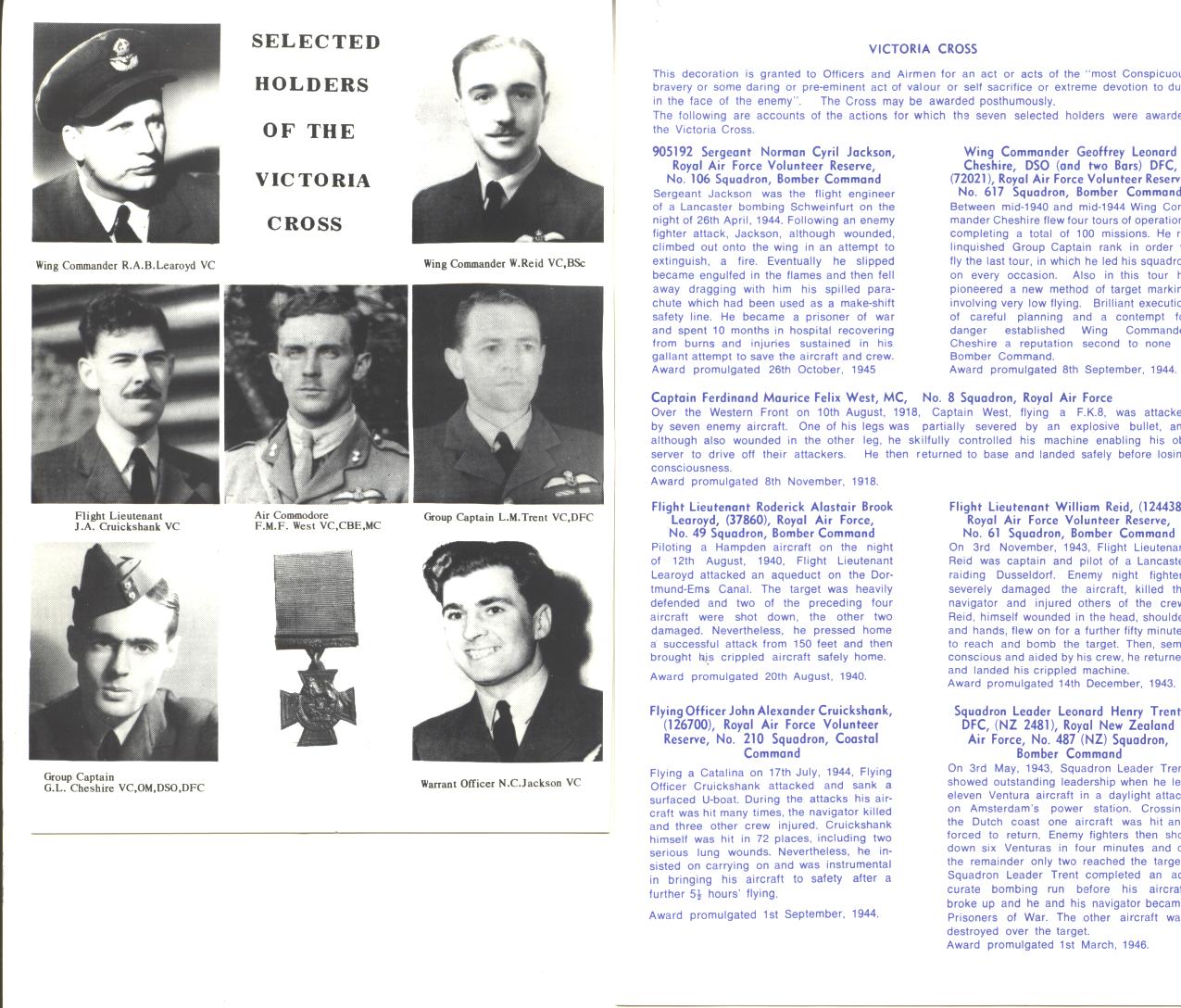

|
FRASER Ian Edward LEAROYD Roderick -Postal Cover signed by two Victoria Cross Recipients
LEAROYD Roderick
Flight Lieutenant Roderick Learoyd
"On 12/13 August 1940 five Handley Page Hampdens of Nos. 49 and 83 Squadrons, after intensive practice-bombing by night of canals in East Anglia, took off to attack this aqueduct. Other Hampdens meanwhile were to make diversionary raids.
First to bomb was Squadron Leader 'Jamie' Pitcairn-Hill DFC, of No 83 who went in at 100 feet and brought back to his badley shot-up machine. Two Hampdens piloted by Australians followed: one managed to attack but both were shot down. The fourth Hampden went in next, bombed, was hit, and crawled back to England on one engine.
The last of the five, through a storm of flak from guns lining both sides of the canal directly along his path, came the Hampden of Flight Lieutenant Roderick 'Babe' Learoyd, of 49 Squadron, who had already flown more than twenty operations. Though blinded by searchlights and having to trust his bomb-aimer, Sergeant John Lewis, Learoyd attacked from 300 feet in a shallow dive and planted a special 'M' Bomb, fused for ten minutes delay, near the bank of the aqueduct. He then brought his badly damaged aircraft, with its hydraulics ruptured and flaps and undercarriage out of action, back to Scampton. It was 2 a.m., and he had to circle around for three hours before dawn broke and he could risk a belly-landing. For his gallantry and determination, Flight Lieuteant Learoyd received the Victoria Cross."
OBITUARY : Wing Cdr Roderick Learoyd VC
CHRISTOPHER FOXLEY-NORRIS
Wing Commander Roderick "Babe" Learoyd was awarded the Victoria Cross for his conduct during a bombing raid over Germany on 12 August 1940.
As one of a series of operations, Acting Flight Lieutenant Learoyd was ordered to lead a formation of Hampden twin- engine bombers (six from his own squadron, No 49) into Germany. The aircraft were slow, unsophisticated, and poorly defended. Their target was the aqueduct carrying the Dortmund-Ems canal.
This was known to be a target of special importance in view of the essential build-up of barges and other shipping for industrial and military support and particularly for the shipping planned for the Channel ports invasion. In view of this the Germans had provided overwhelming anti-aircraft defences in the form of hundreds of guns of all calibres and massed searchlights designed to blind the crews.
The latter had to fly at bombing levels down to 150ft to ensure the necessary accuracy and from a predictable direction obvious to the enemy. Learoyd and his crews were well aware of what they were asked to face, having attacked the canal before. Indeed to fly with bomber command made such experiences familiar to all.
After starting its bombing run Learoyd's aircraft was literally shot to pieces, losing among other things his undercarriage controls and his landing flaps. He later paid tribute to the immense skill and courage of his three-man crew. It is certainly worth noting that one of his gunners was neither an officer nor an NCO but a regular airman, which was quite common in those days in bombers, in Lysanders and in Defiant fighters. These men were paid one shilling and sixpence per day. Their carrier pigeons, one of whom laid an egg while they were over the target, only got rations.
The canal was successfully put out of action for 10 critical days. Having succeeded by a near miracle in escaping its defences, Learoyd arrived back over his base with nearly three hours of darkness still to come. He decided that a night landing would be too dangerous for his crippled aircraft and he orbited till daylight, when he made a perfect belly-landing without undercarriage or flaps and without injury to anyone.
It has sometimes given cause for comment that such experiences did not see the end of wartime flying for RAF pilots. Anything but. Learoyd continued to fly operationally with bomber command, eventually commanding No 44 squadron, which was the first unit to be equipped with the famous four- engined Lancaster bomber.
Like many of those who won the VC, he did not appear to be a particularly likely candidate for that supreme honour. After being educated at Wellington, he pottered about for a few years before taking a short service commission in the Royal Air Force and being posted to bomber command. Operational from the outbreak of war, he soon established a reputation for professional expertise and outstanding determination in locating and attacking heavily defended targets. But he was not an obviously notable or inspirational leader. He was a quiet and reserved man but also a friendly and comradely one. A good man at a party, but never allowing social life to interrupt his fighting career. Even after the award of the VC he gave no hint of conceit or self- importance.
After surviving the war Learoyd retired to civilian life, first as a VIP pilot and later as an export sales manager in the motor industry.
Christopher Foxley-Norris
Roderick Alastair Brook Learoyd, air force officer: born Folkestone 5 February 1913; VC 1940; died 24 January 1996.
Signed Postal cover
FRASER Ian Edward
[ London Gazette, 13 November 1945 ], Jahore Straits, Singapore, 31 July 1945, Lieutenant Ian Edward Fraser DSC, Royal Naval Reserve.
Lieutenant Fraser commanded His Majesty's Midget Submarine XE-3 in a successful attack on a Japanese heavy cruiser of the Atago class at her moorings in Johore Strait, Singapore, on 31st July 1945.
During the long approach up the Singapore Straits XE-3 deliberately left the believed safe channel and entered mined waters to avoid suspected hydrophone posts. The target was aground, or nearly aground, both fore and aft, and only under the Midship portion was there just sufficient water for XE-3 to place herself under the cruiser. For forty minutes XE-3 pushed her way along the seabed until finally Lieutenant Fraser managed to force her right under the centre of the cruiser. Here he placed the limpets and dropped his main side charge. Great difficulty was experienced in extricating the craft after the attack had been completed, but finally XE-3 was clear, and commenced her long return journey out to sea.
The courage and determination of Lieutenant Fraser are beyond all praise. Any man not possessed of his relentless determination to achieve his object in full, regardless of all consequences, would have dropped his side charge alongside the target instead of persisting until he had forced his submarine right under the cruiser. The approach and withdrawal entailed a passage of 80 miles through water which had been mined by both the enemy and ourselves, past hydrophone positions, over loops and controlled minefields, and through an anti-submarine boom.
( Lieutenant Fraser's other crew member in the midget submarine was Leading Seaman James Magennis, Royal Navy, who was also awarded the Victoria Cross ).
Ian Fraser and James Magennis were invested with their Victoria Crosses by King George VI at Buckingham Palace on the 11th December 1945.
Ian Fraser's and James Magennis's Victoria Cross groups are included in the Lord Ashcroft VC Collection and will be on display at the new Ashcroft Gallery at the Imperial War Museum, planned to be opened in 2010.
Information from http://www.victoriacross.org.uk/vcross.htm
Signed Postal cover
Price: $85.00
Please contact us before ordering to confirm availability and shipping costs.
Buy now with your credit card
other ways to buy
|


